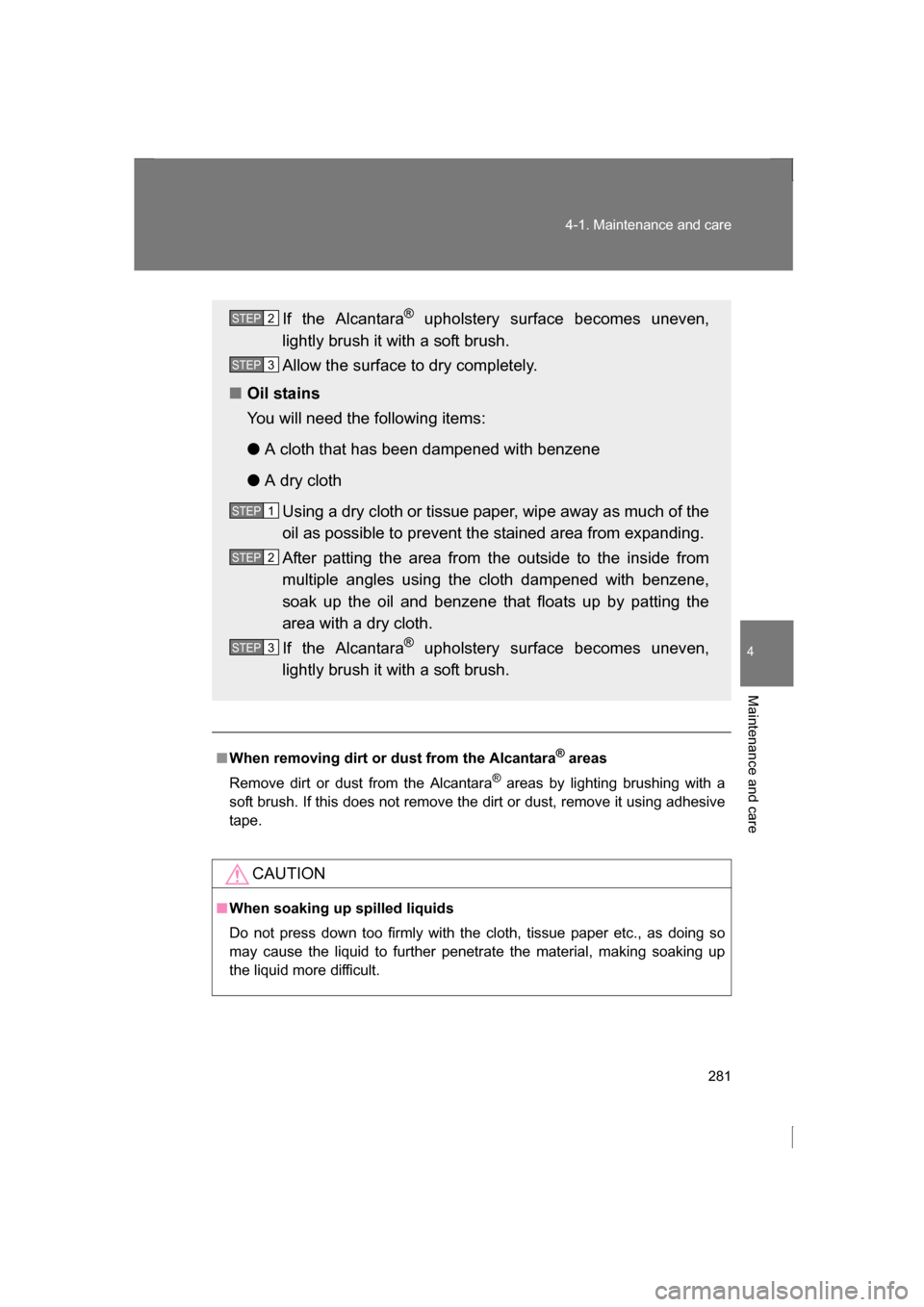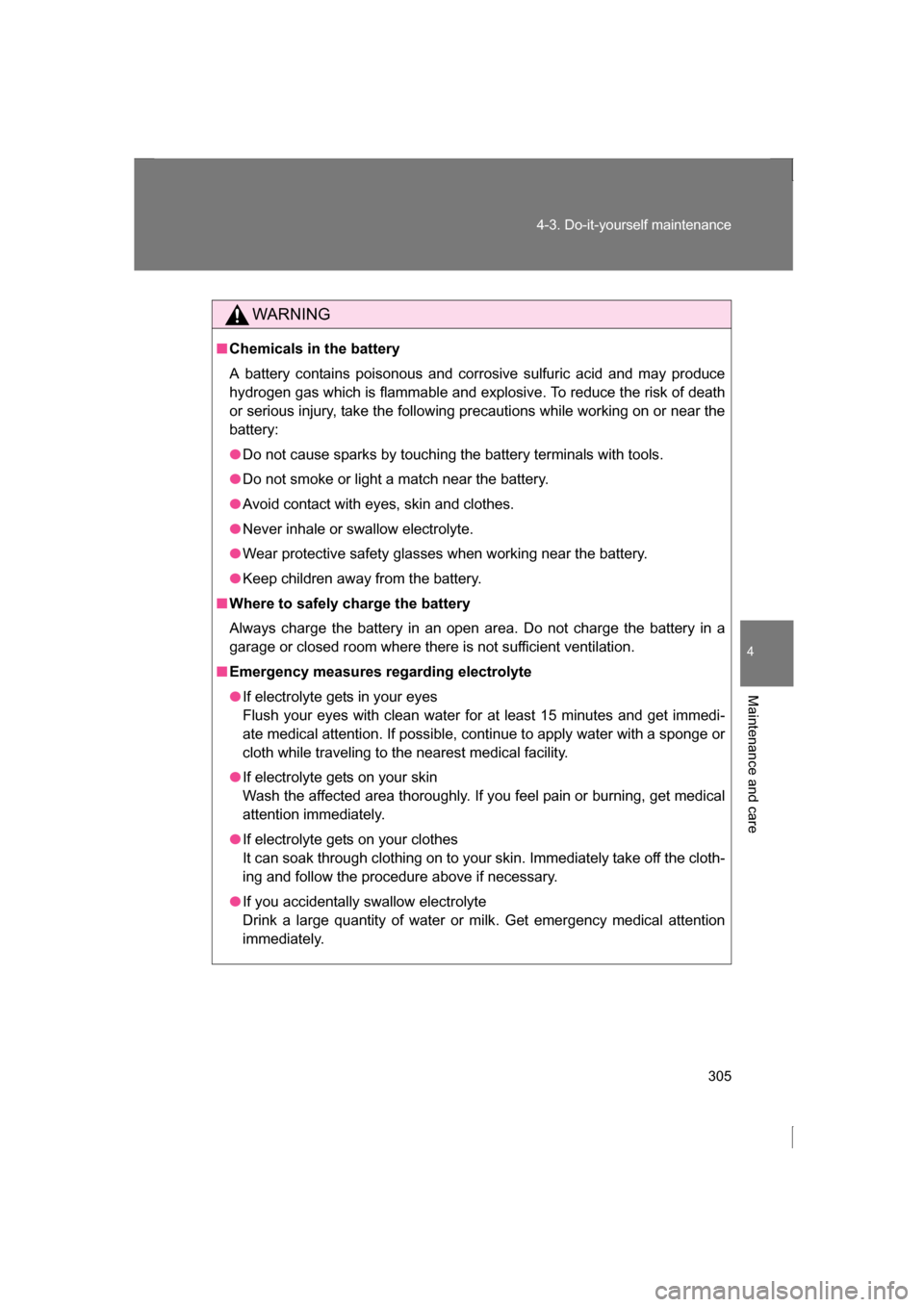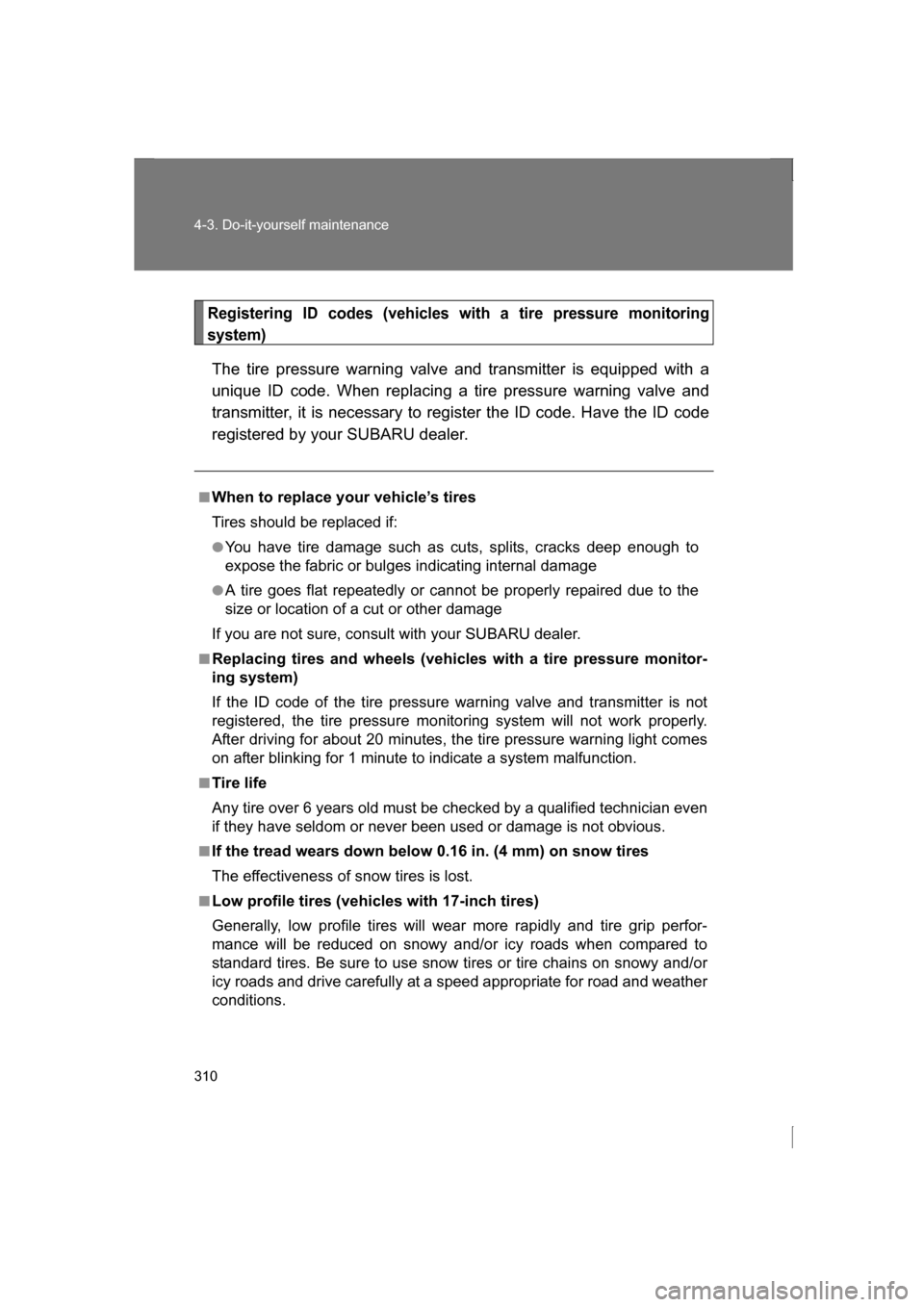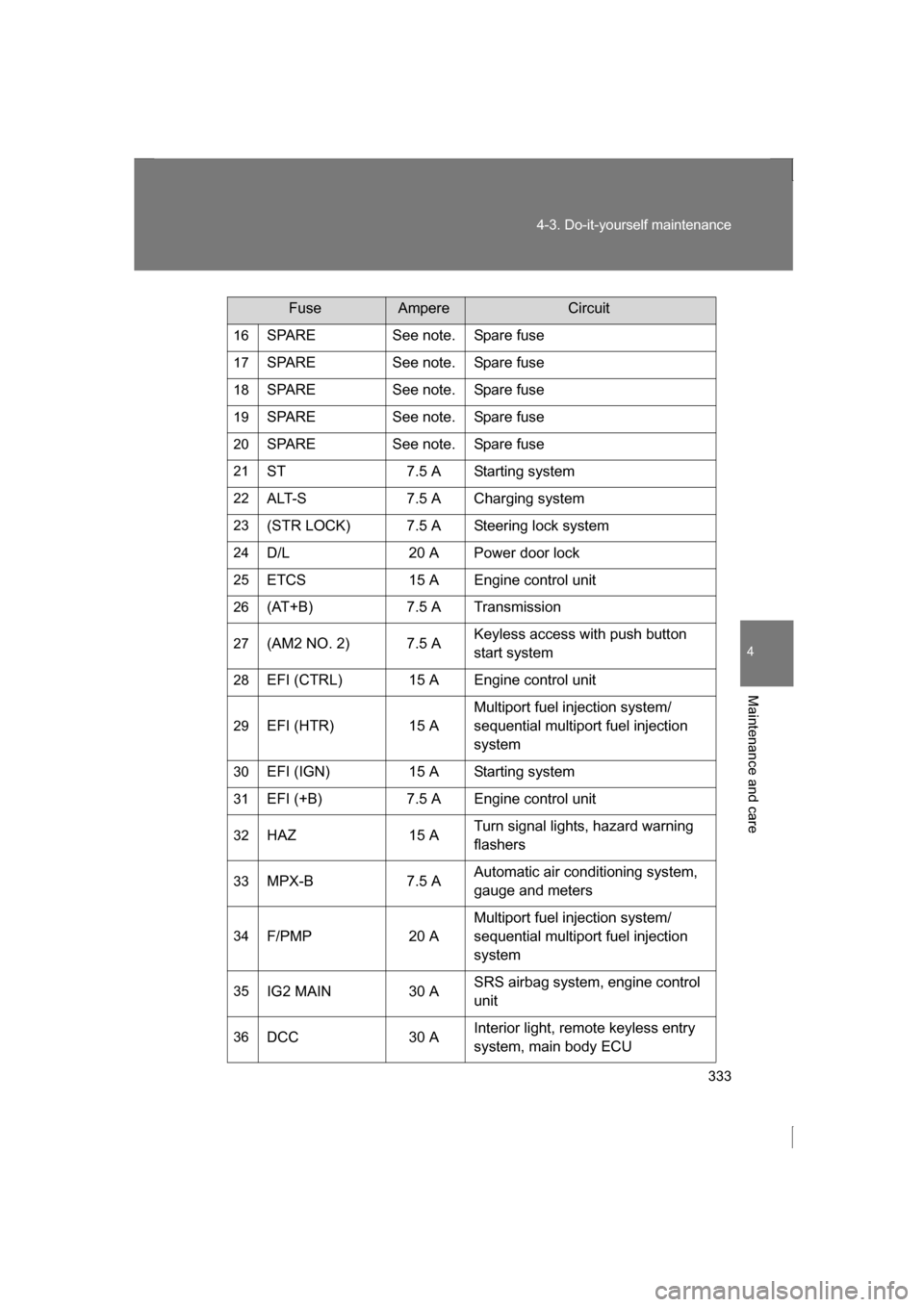Page 281 of 484

281
4-1. Maintenance and care
4
Maintenance and care
■When removing dirt or dust from the Alcantara®
areas
Remove dirt or dust from the Alcantara ®
areas by lighting brushing with a
soft brush. If this does not remove the dirt or dust, remove it using adhesive
tape.
CAUTION
■When soaking up spilled liquids
Do not press down too firmly with the cloth, tissue paper etc., as doing so
may cause the liquid to further penetrate the material, making soaking up
the liquid more difficult.
If the Alcantara ®
upholstery surface becomes uneven,
lightly brush it with a soft brush.
Allow the surface to dry completely.
■Oil stains
You will need the following items: ● A cloth that has been dampened with benzene
● A dry cloth
Using a dry cloth or tissue paper, wipe away as much of the
oil as possible to prevent the stained area from expanding.
After patting the area from the outside to the inside from
multiple angles using the cloth dampened with benzene,
soak up the oil and benzene that floats up by patting the
area with a dry cloth.
If the Alcantara ®
upholstery surface becomes uneven,
lightly brush it with a soft brush.
STEP 2
STEP 3
STEP 1
STEP 2
STEP 3
Page 284 of 484

284
4-2. Maintenance
WARNING
■If your vehicle is not properly maintained
It could result in serious damage to the vehicle and possible serious injury or death.
■Warning in handling of battery
●Before beginning work on or near any battery, be sure to extinguish all cig-
arettes, matches, and lighters. Never expose a battery to an open flame or
electric sparks. Batteries give off a gas which is highly flammable and
explosive.
●For safety, in case an explosion does occur, wear eye protection or shield
your eyes when working near any battery. Never lean over a battery.
●Do not let battery fluid contact eyes, skin, fabrics, or paint because battery
fluid is a corrosive acid. If battery fluid gets on your skin or in your eyes,
immediately flush the area with water thoroughly. Seek medical help
immediately if acid has entered the eyes.
If battery fluid is accidentally swallowed, immediately drink a large amount
of milk or water, and seek medical attention immediately.
●To lessen the risk of sparks, remove rings, metal watchbands, and other
metal jewelry. Never allow metal tools to contact the positive battery termi-
nal and anything connected to it WHILE you are at the same time in con-
tact with any other metallic portion of the vehicle because a short circuit
will result.
●Keep everyone including children away from the battery.
●Charge the battery in a wellventilated area.
●Battery posts, terminals and related accessories contain lead and lead
compounds, chemicals known to the State of California to cause cancer
and reproductive harm. Batteries also contain other chemicals known to
the State of California to cause cancer. Wash hands after handling.
Page 290 of 484
290
4-3. Do-it-yourself maintenance
ItemsParts and tools
Light bulbs ( →P. 337)
Page 292 of 484
292
4-3. Do-it-yourself maintenance
Engine hood
Release the lock from the inside of the vehicle to open the engine
hood.Pull the engine hood release
lever.The engine hood will pop up
slightly.
Push the auxiliary catch lever
to the left and lift the engine
hood.
Hold the engine hood open by
inserting the supporting rod
into the slot.
STEP 1
STEP 2
STEP 3
Page 301 of 484
301
4-3. Do-it-yourself maintenance
4
Maintenance and care
■Adding fluid
Make sure to check the fluid type and prepare the necessary items.
Fluid typeFMVSS No.116 fresh DOT 3 or DOT 4 brake fluid
ItemsClean funnel
■Brake fluid can absorb moisture from the air
Excess moisture in the fluid can cause a dangerous loss of braking effi-
ciency. Use only newly opened brake fluid.
WARNING
■When filling the reservoir
Take care because brake fluid can harm your hands or eyes and damage
painted surfaces.
If fluid gets in your eyes, flush your eyes with clean water immediately.
If you still experience discomfort, see a doctor.
CAUTION
■If the fluid level is low or high
It is normal for the brake fluid level to go down slightly as the brake pads
wear or when the fluid level in the accumulator is high.
If the reservoir needs frequent refilling, it may indicate a serious problem.
Page 305 of 484

305
4-3. Do-it-yourself maintenance
4
Maintenance and care
WARNING
■Chemicals in the battery
A battery contains poisonous and corrosive sulfuric acid and may produce
hydrogen gas which is flammable and explosive. To reduce the risk of death
or serious injury, take the following precautions while working on or near the
battery:
●Do not cause sparks by touching the battery terminals with tools.
●Do not smoke or light a match near the battery.
●Avoid contact with eyes, skin and clothes.
●Never inhale or swallow electrolyte.
●Wear protective safety glasses when working near the battery.
●Keep children away from the battery.
■Where to safely charge the battery
Always charge the battery in an open area. Do not charge the battery in a
garage or closed room where there is not sufficient ventilation.
■Emergency measures regarding electrolyte
●If electrolyte gets in your eyes
Flush your eyes with clean water for at least 15 minutes and get immedi-
ate medical attention. If possible, continue to apply water with a sponge or
cloth while traveling to the nearest medical facility.
●If electrolyte gets on your skin
Wash the affected area thoroughly. If you feel pain or burning, get medical
attention immediately.
●If electrolyte gets on your clothes
It can soak through clothing on to your skin. Immediately take off the cloth-
ing and follow the procedure above if necessary.
●If you accidentally swallow electrolyte
Drink a large quantity of water or milk. Get emergency medical attention
immediately.
Page 310 of 484

310
4-3. Do-it-yourself maintenance
Registering ID codes (vehicles with a tire pressure monitoring
system)
The tire pressure warning valve and transmitter is equipped with a
unique ID code. When replacing a tire pressure warning valve and
transmitter, it is necessary to register the ID code. Have the ID code
registered by your SUBARU dealer.
■When to replace your vehicle’s tires
Tires should be replaced if:
●You have tire damage such as cuts, splits, cracks deep enough to
expose the fabric or bulges indicating internal damage
●A tire goes flat repeatedly or cannot be properly repaired due to the
size or location of a cut or other damage
If you are not sure, consult with your SUBARU dealer.
■Replacing tires and wheels (vehicles with a tire pressure monitor-
ing system)
If the ID code of the tire pressure warning valve and transmitter is not
registered, the tire pressure monitoring system will not work properly.
After driving for about 20 minutes, the tire pressure warning light comes
on after blinking for 1 minute to indicate a system malfunction.
■Tire life
Any tire over 6 years old must be checked by a qualified technician even
if they have seldom or never been used or damage is not obvious.
■If the tread wears down below 0.16 in. (4 mm) on snow tires
The effectiveness of snow tires is lost.
■Low profile tires (vehicles with 17-inch tires)
Generally, low profile tires will wear more rapidly and tire grip perfor-
mance will be reduced on snowy and/or icy roads when compared to
standard tires. Be sure to use snow tires or tire chains on snowy and/or
icy roads and drive carefully at a speed appropriate for road and weather
conditions.
Page 333 of 484

333
4-3. Do-it-yourself maintenance
4
Maintenance and care
16SPARE See note. Spare fuse
17 SPARE See note. Spare fuse
18 SPARE See note. Spare fuse
19 SPARE See note. Spare fuse
20 SPARE See note. Spare fuse
21 ST 7.5 A Starting system
22 ALT-S 7.5 A Charging system
23 (STR LOCK) 7.5 A Steering lock system
24 D/L 20 A Power door lock
25 ETCS 15 A Engine control unit
26 (AT+B) 7.5 A Transmission
27 (AM2 NO. 2) 7.5 A Keyless access with push button
start system
28 EFI (CTRL) 15 A Engine control unit
29 EFI (HTR) 15 A Multiport fuel injection system/
sequential multiport fuel injection
system
30 EFI (IGN) 15 A Starting system
31 EFI (+B) 7.5 A Engine control unit
32 HAZ 15 A Turn signal lights, hazard warning
flashers
33 MPX-B 7.5 A Automatic air condi
tioning system,
gauge and meters
34 F/PMP 20 A Multiport fuel injection system/
sequential multiport fuel injection
system
35 IG2 MAIN 30 A SRS airbag system, engine control unit
36 DCC 30 A Interior light, remote keyless entry
system, main body ECU
FuseAmpereCircuit